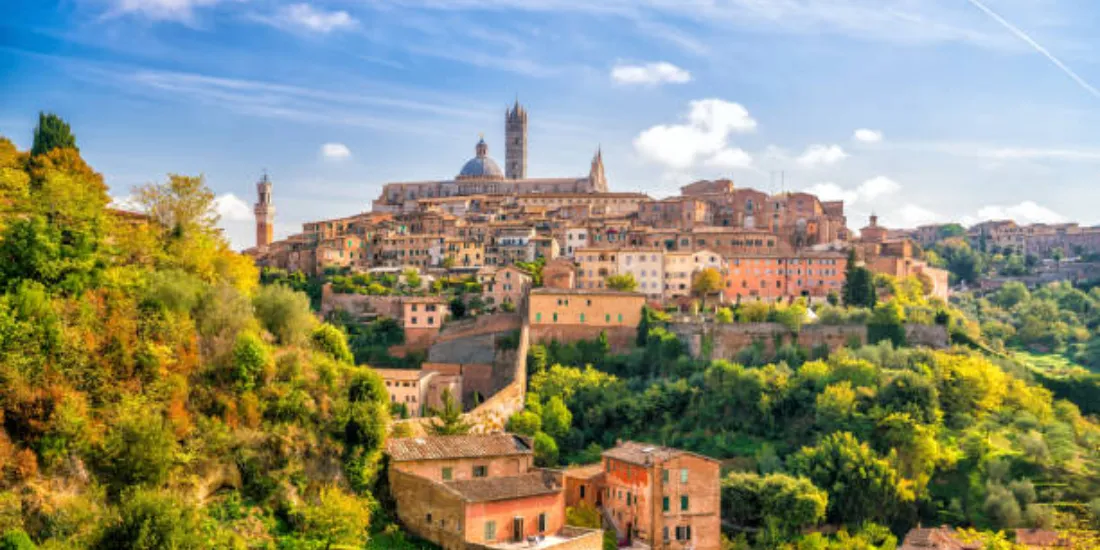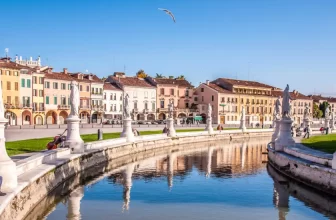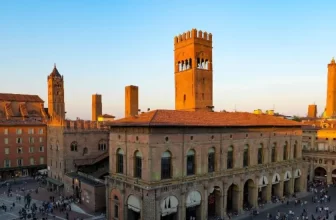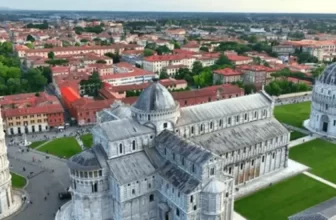
About the City – What It’s Like to Study in Tuscania
To study in Tuscania is to live inside a postcard. A real one. Think cobblestone alleyways, medieval towers, Etruscan ruins, and cafes where the barista knows your name, and your regular order.
Located in northern Lazio, about 90 km from Rome, Tuscania sits quietly in the Italian countryside. But don’t let the size fool you. This small town is big on history, culture, and inspiration. With a population under 10,000, it’s peaceful, safe, and bursting with old-world charm.
And for students? It’s kind of perfect. Because you’re not battling urban chaos. You’re immersed in Italian life. Locals greet you with a smile. Professors know you by name. Classrooms open up to rolling hills. You’re not just learning, you’re living like a local. It’s immersive, authentic, and, honestly, completely magical.
For those dreaming of studying abroad without the hustle of big cities, Tuscania is a hidden gem worth discovering.
Why Tuscania Is Important for International Students
1. A Gateway to Authentic Italian Life
In Tuscania, you don’t just visit Italy, you live it. Studying here means integrating into daily Italian life. Shopping at farmer’s markets, attending local festivals, and practicing your Italian with native speakers every day. It’s the kind of language immersion no classroom alone can provide.
2. Intimate Academic Atmosphere
Tuscania is known for its close-knit educational approach. Classes are small, often less than 20 students, meaning personalized attention and richer discussion. Whether you’re doing a semester in architecture, history, art, agriculture, or language, you’ll form meaningful connections with professors and peers.
3. Perfect Launchpad for Travel
Being only 90 minutes from Rome and 2.5 hours from Florence, Tuscania is ideal for weekend trips and academic excursions. You’re nestled in history surrounded by famous neighbors like Viterbo, Tarquinia, and the Tyrrhenian coast.
4. Safe and Student-Focused Lifestyle
With a low crime rate and a welcoming local population, Tuscania offers international students a supportive, quiet place to focus on studies and self-exploration. It’s a much-needed contrast from high-speed urban life.
5. Affordable Yet Rich in Culture
Costs here are a fraction of what you’d pay in Rome or Milan. Yet the experience is just as rich, if not more so. From local cuisine to ancient cathedrals, Tuscania proves that smaller doesn’t mean lesser, it means deeper.
Top 10 Universities or Colleges in Tuscania
Tuscania may be small, but it punches above its weight when it comes to quality education and immersive learning.
- Lorenzo de’ Medici (LdM) – Tuscania Campus
Known for fine arts, archaeology, gastronomy, and Italian culture. Offers semester abroad, summer courses, and full-time study options. Small class sizes, English-taught programs. - Istituto Agrario “A. Serpieri”
A local agricultural institute offering vocational programs in sustainable farming, food science, and environmental studies. - Università degli Studi della Tuscia – Extension Programs
While headquartered in Viterbo, Tuscia University occasionally hosts short-term programs and joint research initiatives in Tuscania, especially in archaeology and environmental studies. - Accademia Italiana – Partner Programs
Occasional workshops in Tuscania in collaboration with partners offering design, fashion, and photography modules. - BCA Study Abroad – Tuscania Program
German and American colleges partner with BCA to offer international liberal arts semesters focusing on Italian life and language. - Umbra Institute Extensions
Partners with LdM to bring intensive language and cultural modules. - ISA Study Abroad – Italy Programs
Occasional immersion programs with Tuscania as base; arts, culture, and cuisine-focused. - CEA CAPA – Tuscania Cultural Programs
Short art courses exploring Etruscan sites, Italian rural life, and Mediterranean heritage. - Cultural Heritage Education Center
Collaborates on archaeological digs and preservation courses tailored for anthropology and classics majors. - USR Lazio Language School
Offers beginner to intermediate Italian classes designed for international learners settling in the region.
Top 10 Student Accommodation Properties in Tuscania
- LdM Student Apartments (Via della Rocca)
- Residence San Giacomo
- Borgo degli Olivi Student Housing
- Via Nazario Sauro Studios
- Casa Mura Apartments
- Terrazza della Torre
- Tuscania Centro Shared Residences
- La Canonica Urban Lofts
- La Fonte Student Apartments
- Via Roma Student Housing
These properties are typically fully furnished, close to campus, and often include utilities. Many are within walking distance of markets, cafes, and all the essentials.
Top 10 Student Areas in Tuscania
1. Centro Storico (Historic Center)
- Nearby: LdM Campus
- Housing: Casa Mura, Residence San Giacomo
Cobbled streets, medieval towers, and ancient churches define this area. It’s quiet but central, with charming flats and local grocers around the corner.
2. Via della Rocca
- Nearby: LdM Main Classroom Hub
- Housing: LdM apartments
Scenic and strategic. Home to many international students. Great views. Historic energy.
3. Borgo dell’Olivo
- Nearby: Countryside design studios
- Housing: Borgo degli Olivi
Pictured-perfect. Ideal for students wanting peace, nature, and a bit of Tuscan tranquility.
4. Via Nazario Sauro
- Nearby: All classroom facilities
- Housing: Budget-friendly studio options
More modern and practical. Less touristy, more “live-like-a-local” feel.
5. Piazza Basile
- Nearby: Cafés and mini-markets
- Housing: Shared flats, student townhouses
Social and central. Known for its evening buzz and student meetups.
6. Via Roma
- Nearby: Bus connections
- Housing: Via Roma Student Housing
Convenient access to Rome-bound buses and all daily essentials. Well-connected.
7. Contrada Valle
- Nearby: Eco-focused study spaces
- Housing: La Fonte Apartments
More natural and scenic routes. Great for quiet study and thoughtful walks.
8. La Canonica Area
- Nearby: Art and theology workshops
- Housing: Canonica Lofts
Architectural charm, quieter crowd. Perfect for art and culture students.
9. Strada del Piano
- Nearby: Agricultural institute
- Housing: Rural homestays and student flats
Closer to the fields, literally. Great for farm and food science students.
10. Santa Maria Maggiore Vicinity
- Nearby: Cathedrals, town hall, and culture centers
- Housing: Boutique-style flats
Photogenic and historical. Expensive, but worth it for the ambience.
Cost of Living in Tuscania – A Student’s Monthly Budget
Tuscania is refreshingly affordable compared to most Italian university cities. Even compared to nearby Rome or Florence, your euro goes further here.
| Category | Estimated Monthly Cost (€) |
|---|---|
| Rent (shared/studio) | €250 – €500 |
| Groceries & Meals | €150 – €200 |
| Utilities & Internet | €50 – €70 |
| Public Transport/Bus Pass | €30 – €50 |
| Mobile & Internet Plan | €20 – €30 |
| Social & Personal | €60 – €120 |
➡️ Monthly Total Estimate: €550 – €950
Easy savings tips:
- Walk everywhere, no need to pay for daily transport
- Buy fresh produce from weekly farmers’ markets
- Cook at home. Pizzerias are cheap, but restaurants add up
- Split housing with classmates; most share 2-3 bed flats
Affordable and easygoing. A rare combo for study abroad life.
Local Transport Facilities for Students
While Tuscania is compact and walkable, here’s the local movement lowdown:
1. Regional Buses
Daily, affordable connections to Viterbo and Rome. ATAC and COTRAL buses are reliable with student discounts.
2. School Shuttle Services
Many study abroad programs (like LdM) offer direct shuttles to archaeological sites or field-class destinations.
3. Walking/Biking
99% of the town is within walking distance. A second-hand bike is a solid investment if you’re staying longer.
4. Intercity Trains
The closest major station in Viterbo offers easy train access to Rome, Florence, and beyond. You’ll love weekend getaways.
Summary – Why You Should Study in Tuscania
To study in Tuscania is to experience the slow rhythm of Italian life with all the perks of a tailored, world-class education. Here, you’ll find charming surroundings, intimate classrooms, and locals who welcome you not like visitors, but like you belong.
It’s not about towering campuses or sprawling metros, it’s about the depth of learning. In culture. In connection. In everyday life. Tuscania is made for those who want more than just a diploma. It’s for those who want stories. Slower days. And the kind of education that’s as personal as it is global.
Top 10 FAQs About Studying in Tuscania
1. Is Tuscania a good place for international students?
Yes! It’s immersive, authentic, safe, and specifically tailored toward study abroad students.
2. Are there English-taught programs in Tuscania?
Absolutely. Institutions like Lorenzo de’ Medici offer fully English-taught courses.
3. Is it expensive to live in Tuscania?
Not at all. You can live comfortably for €550–€950/month, including rent, food, and extras.
4. What types of programs are available?
Art, archaeology, gastronomy, history, Italian language, and cultural studies are the most popular.
5. Can I visit bigger cities from Tuscania?
Yes. Rome is just 90 minutes away by bus or train. Florence is also an easy trip.
6. Is public transport student-friendly?
Yes. Regional passes are affordable, and most students live walking distance from school.
7. Are there part-time jobs for students?
Not easily available. This town is study-focused. Most students don’t work part-time here.
8. Will I need to know Italian?
A little helps! But if you’re enrolled in an English-language program, it’s not required for study.
9. Is it safe?
Extremely. It’s a small town with a close-knit, welcoming community.
10. Why choose Tuscania over bigger cities like Rome or Florence?
Lower costs, deeper cultural immersion, fewer distractions, and a lifestyle that gives you space to breathe, learn, and grow.






